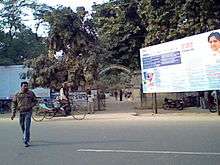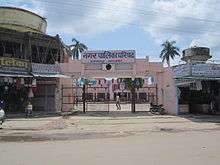Nawabganj, Barabanki
| Nawabganj, Barabanki Nawabganj नवाबगंज نوابگنج | |
|---|---|
| town | |
 Nawabganj, Barabanki Location in Uttar Pradesh, India | |
| Coordinates: 26°56′N 81°11′E / 26.94°N 81.19°ECoordinates: 26°56′N 81°11′E / 26.94°N 81.19°E | |
| Country |
|
| State | Uttar Pradesh |
| District | Barabanki |
| Government | |
| • Chairman | Ranjeet Bahadur Srivastava |
| Elevation | 93 m (305 ft) |
| Population (2001)[1] | |
| • Total | 806,929 |
| Languages | |
| • Official | Hindi, Urdu |
| Time zone | IST (UTC+5:30) |
| PIN | 225001 |
| Telephone code | 05248 |
| Vehicle registration | UP-41 |
| Website |
nppnawabganj |
Nawabganj is a town in Barabanki district in the state of Uttar Pradesh, India. It is a tehsil and nagar parishad for Barabanki town.[2] It is one of the constituent entities of Barabanki city, which is District HQ of Barabanki district.
History
Nawabganj has been known as such since the Nawabi.[3]
Battle of Nawabganj
| Battle of Nawabganj | |||||||
|---|---|---|---|---|---|---|---|
| Part of the Indian Mutiny | |||||||
| |||||||
| Belligerents | |||||||
| East India Company |
rebel sepoys Oudh State Local Taluqdars | ||||||
| Commanders and leaders | |||||||
| Sir Hope Grant |
Maulvi Ahmadullah Shah Raja Balbhadra Singh of Chahlari | ||||||
| Strength | |||||||
| 5000 | 16000 | ||||||
| Casualties and losses | |||||||
|
36 killed 62 wounded | 1000 killed and wounded | ||||||
Battle of Nawabganj was a conflict between rebel sepoys, troops of Oudh State and local Taluqdars and troops of East India Company from 12 to 14 June 1857 during Indian Mutiny.[4]
During the Sepoy war of 1857-1858 the whole of the Bara Banki taluqdars joined the mutineers, but offered no serious resistance after the capture of Lucknow.[5][6] In the battle of Nawabganj in 1857 at Nawabganj Sir Hope Grant defeated the revolutionaries.[7] Raja Balbhadra Singh Chehlari along with other 1000 revolutionaries were killed in action while fighting British at Obri around 2 km from Barabanki on the confluence of riverlets Rait and Jamuria.[8][9][10][11]
British Rule
During the British rule Nawabganj headquarters of tehsil and pargana of same name. Area of Nawabganj Pargana around 1878 was 79 square miles and it was bounded in North by Ramnagar and Fatehpur, on the east by Daryabad, on the west by Dewa, and on south by Partabganj. Out of 77 villages, 44 were taluqdari and 33 Mufrad. Out of 44 taluqdari villages 25 were held by Jahngirabad Estate, the rest were divided between several neighbouring estates. Nawabganj contained village of Bara Banki which had civil railway station having junction on Oudh and Rohilkhand Railway (about half a mile north of the town).[12]
Geography
Nawabganj is located at 26°56′N 81°11′E / 26.94°N 81.19°E. It has an average elevation of 93 metres (305 feet).
Demographics
As of 2001 India census,[13] Nawabganj had a population of 75,087. Males constitute 52% of the population and females 48%. Nawabganj has an average literacy rate of 66%, higher than the national average of 59.5%: male literacy is 70%, and female literacy is 62%. In Nawabganj, 12% of the population is under 6 years of age.
Administration
Tehsil Nawabganj

Tehsil Nawabganj has 4 Block panchayats,[14] they are:

Nagar Palika Parishad Nawabganj has 25 wards.[15] They are:
| Ward No. | Name | Population (2001) |
|---|---|---|
| 1 | Gandhi Nagar | 3148 |
| 2 | Valmiki Nagar | 5309 |
| 3 | Peer Batawan Saravgi | 1913 |
| 4 | Begumganj Saravgi | 3060 |
| 5 | Kanoongoyan Poorvi | 3000 |
| 6 | Poorvi Peerbatawan | 3180 |
| 7 | Police Line | 2259 |
| 8 | Lajpat Nagar | 2216 |
| 9 | Gularia Gaarda | 2782 |
| 10 | Azad Nagar | 3208 |
| 11 | Kanoongoyan | 2574 |
| 12 | Tehsil Colony | 2948 |
| 13 | Katra Baradari | 2969 |
| 14 | Satypremi Nagar | 2103 |
| 15 | Kailash Ashram | 3412 |
| 16 | Durgapuri | 3788 |
| 17 | Nehru Nagar | 2680 |
| 18 | Munshiganj | 1882 |
| 19 | Bheetri Peerbatawan | 4526 |
| 20 | Barhiyan Tola | 3174 |
| 21 | Barhiyan Pashchimi | 3253 |
| 22 | Dushehrabagh | 4603 |
| 23 | Bheetri Poorvi | 3424 |
| 24 | Saravgi | 1489 |
| 25 | Rasoolpur | 2591 |
Health infrastructure
Tehsil Nawabganj has following health infrastructure:[16]
- Health centres – 7
- PHCs – 8
- Sub centres – 17
References
- ↑ Nawabganj Population
- ↑ Barabanki Information on District Administration
- ↑ Benett, William Charles (1878). Gazetteer of the Province of Oudh...: H to M (Volume 2 of Gazetteer of the Province of Oudh ed.). Printed at the Oudh Government Press. pp. 8–10. Retrieved 6 August 2014.
- ↑ Benett, William Charles (1878). Gazetteer of the Province of Oudh...: H to M (Volume 2 of Gazetteer of the Province of Oudh ed.). Printed at the Oudh Government Press. pp. 8–10. Retrieved 6 August 2014.
- ↑ Gazetteer of the province of Oudh, BARA BANKI DISTRICT ARTICLE #226-263
- ↑
 One or more of the preceding sentences incorporates text from a publication now in the public domain: Chisholm, Hugh, ed. (1911). "Bara Banki". Encyclopædia Britannica. 3 (11th ed.). Cambridge University Press.
One or more of the preceding sentences incorporates text from a publication now in the public domain: Chisholm, Hugh, ed. (1911). "Bara Banki". Encyclopædia Britannica. 3 (11th ed.). Cambridge University Press. - ↑ The geography of British India, political & physical By George Smith
- ↑ Raja Balbhadra Singh Chehlari @ nppnawabganj.in
- ↑ ORIGIN OF NAME OF DISTRICT @ nppnawabganj.in
- ↑
- ↑ Misra, Amaresh (2004). Lucknow:Fire Of Grace. Rupa Publications. ISBN 9788129104854. Retrieved 6 August 2014.
- ↑ Benett, William Charles (1878). Gazetteer of the Province of Oudh...: H to M (Volume 2 of Gazetteer of the Province of Oudh ed.). Printed at the Oudh Government Press. pp. 8–10. Retrieved 6 August 2014.
- ↑ "Census of India 2001: Data from the 2001 Census, including cities, villages and towns (Provisional)". Census Commission of India. Archived from the original on 2004-06-16. Retrieved 2008-11-01.
- ↑ Population
- ↑ http://nppnawabganj.in/population.aspx
- ↑ http://jsk.gov.in/hindi/up/up_barabanki.pdf